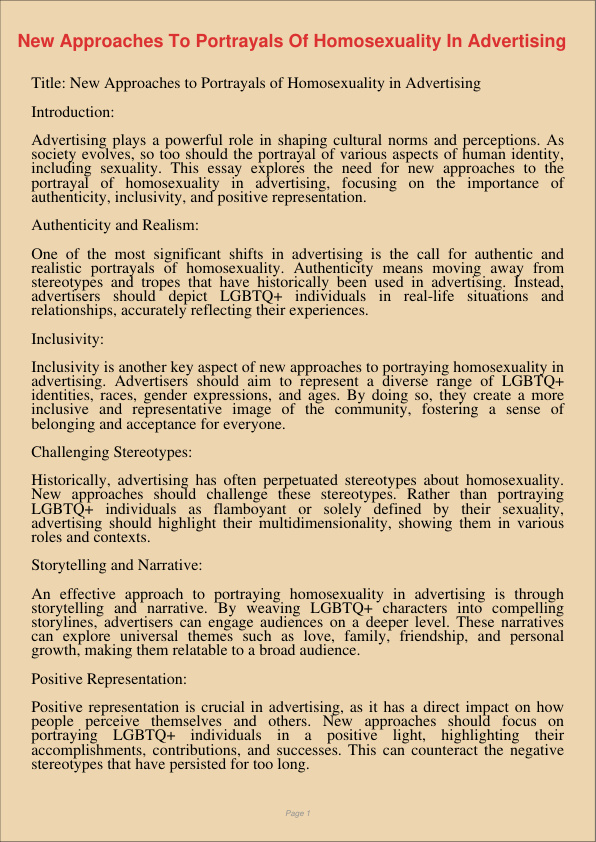Title: New Approaches to Portrayals of Homosexuality in Advertising
Introduction:
Advertising plays a powerful role in shaping cultural norms and perceptions. As society evolves, so too should the portrayal of various aspects of human identity, including sexuality. This essay explores the need for new approaches to the portrayal of homosexuality in advertising, focusing on the importance of authenticity, inclusivity, and positive representation.
Authenticity and Realism:
One of the most significant shifts in advertising is the call for authentic and realistic portrayals of homosexuality. Authenticity means moving away from stereotypes and tropes that have historically been used in advertising. Instead, advertisers should depict LGBTQ+ individuals in real-life situations and relationships, accurately reflecting their experiences.
Inclusivity:
Inclusivity is another key aspect of new approaches to portraying homosexuality in advertising. Advertisers should aim to represent a diverse range of LGBTQ+ identities, races, gender expressions, and ages. By doing so, they create a more inclusive and representative image of the community, fostering a sense of belonging and acceptance for everyone.
Challenging Stereotypes:
Historically, advertising has often perpetuated stereotypes about homosexuality. New approaches should challenge these stereotypes. Rather than portraying LGBTQ+ individuals as flamboyant or solely defined by their sexuality, advertising should highlight their multidimensionality, showing them in various roles and contexts.
Storytelling and Narrative:
An effective approach to portraying homosexuality in advertising is through storytelling and narrative. By weaving LGBTQ+ characters into compelling storylines, advertisers can engage audiences on a deeper level. These narratives can explore universal themes such as love, family, friendship, and personal growth, making them relatable to a broad audience.
Positive Representation:
Positive representation is crucial in advertising, as it has a direct impact on how people perceive themselves and others. New approaches should focus on portraying LGBTQ+ individuals in a positive light, highlighting their accomplishments, contributions, and successes. This can counteract the negative stereotypes that have persisted for too long.
Social Responsibility:
Advertisers have a social responsibility to contribute to a more accepting and diverse society. By showcasing LGBTQ+ individuals and their stories, they can actively support social progress and promote understanding and empathy among viewers.
Partnering with LGBTQ+ Advocacy Groups:
To create meaningful change in the portrayal of homosexuality in advertising, companies can collaborate with LGBTQ+ advocacy organizations. By working together, advertisers can gain insights, guidance, and valuable input on how to represent the community accurately and respectfully.
Open Dialogue with Audiences:
Adopting new approaches requires open dialogue with audiences. Advertisers can engage with the LGBTQ+ community to gather feedback, understand their needs, and ensure that their portrayals are respectful and impactful. This collaborative approach can lead to more authentic and meaningful representations.
Conclusion:
In today’s world, advertising has a unique opportunity to reshape perceptions and challenge stereotypes surrounding homosexuality. New approaches should prioritize authenticity, inclusivity, and positive representation while telling compelling stories that engage audiences on a personal level. By taking on the social responsibility of portraying homosexuality with respect and empathy, advertisers can contribute to a more inclusive and accepting society. These changes not only benefit the LGBTQ+ community but also advance the cause of diversity and equality for all.

「真诚赞赏,手留余香」
真诚赞赏,手留余香
使用微信扫描二维码完成支付
